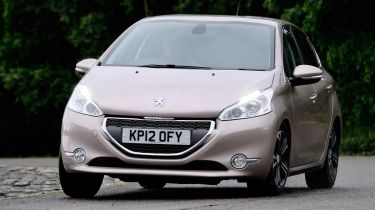Peugeot 208
Efficient diesel version looks to build on all-new supermini’s impressive debut
Making an impact with your new supermini is never easy, but the Peugeot 208 debuted with a bang in May, winning its first-ever group test. It edged out the Ford Fiesta thanks to its lower price and brilliant three-cylinder engine. So can this efficient diesel version build on that strong start?
It certainly shows the Yaris Hybrid a clean pair of heels in the style department. The soft, sculpted curves are in total contrast to the Toyota’s angular lines, while details like the intricate LED tail-lights and floating chrome grille ensure the Peugeot has chic to spare.
Two-tone 16-inch alloys are standard on our Allure test car, and this trim also boasts smart chrome front foglight surrounds, rear privacy glass and LED daytime running lights. Rose Quartz paint wouldn’t be our choice, but the strength of the 208’s design means it makes a real statement.
Peugeot is keen for the 208 to end the firm’s reputation for flimsy build quality, and all the effort put into the cabin has paid off. Gloss-black and soft-touch plastics cover the dash and centre console, helping to give more upmarket appeal than the Yaris.
The sports seats are comfortable and supportive, while there’s lots of kit, such as a colour multifunction screen, dual-zone climate control and auto lights and wipers.
Used - available now
However, there are some packaging issues. The clutch pedal is high, so finding a comfy driving position is difficult. Also, the main instruments have been raised, which means some drivers will have their view blocked by the leather steering wheel’s rim. Other niggles include the tiny glovebox and fiddly touchscreen infotainment system.
The Peugeot does have space on its side, as it’s wider and longer than the Yaris, with a bigger wheelbase, freeing up room inside. Taller passengers in the back will find that headroom is a little tight, but because the 208 has no battery pack sitting beneath the seats, its footwells are roomier.
Where the Peugeot really pulls out an advantage is on the move. Its conventional drivetrain is noisier than the Yaris’ at a standstill, but once up to speed, the manual gearbox and longer gear ratios make it a much more refined motorway cruiser.
The Yaris posted similar times during our track tests, but in reality the 208 feels quicker thanks to its muscular low-speed response. Despite a soft ride, it grips better in corners, too. The steering is light but feels less remote than in the Yaris and it’s just as easy to drive.
More importantly for eco-minded buyers, Peugeot’s e-HDi system works well in town, cutting the engine below 12mph to help save even more fuel while rolling up to the lights.
Returning 43.4mpg on test, the 208 came close to matching the Toyota’s running costs – but pricey servicing and weaker residuals could stop it claiming a second road-test win.
Details
Chart position: 1Why? The new 208 is smaller and lighter than the car it replaces, while the e-HDi stop-start system promises efficient motoring with no compromise to space or style.











